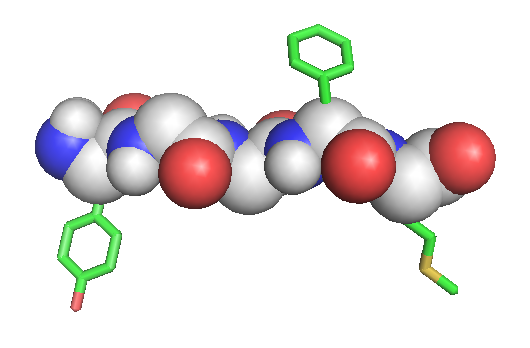Quick Test with Enkephalin

To test if RIP is working, we can do a quick RIP on the endorphin Enkephalin, a pentapeptide (Tyr-Gly-Gly-Phe-Met) often used to calibrate MD simulations. To view the enkephalin structure (after making sure that SHOWPDB.PY is installed correctly), run the following from the scripts directory:
python showpdb.py -g white -e ../examples/enkephalin/enkephalin.pdb
This will render the peptide in backbone-sphere mode "-e" with a white background "-g white".
Running the RIP Simulations
Although enkephalin is too small to produce any meaningful flexibility analysis, it only takes 10 minutes to run on my iMac with a 2.6 GHz Intel processor. To run, go to the 'pdbtool' directory:
python perturb.py ../examples/enkephalin/enkephalin.config
If all goes well, PERTURB.PY will create the directory
examples/enkephalin/300k-rip-300k
In this directory, there will be the directories: 1, 4 and 5, corresponding to RIP perturbations on residues Tyr-1, Phe-4 and Met-5 of enkephalin. In each directory, there will a bunch of files associated with the trajectory starting with 'md'.
Looking at the trajectory of RIP on Phe-4
In order to view the trajectories, we can use PYTRAJ.PY. To view the RIP perturbation on Phe-4 (where '-e' shows the backbone as spheres), go to the 'pdbtool' directory and run:
python pytraj.py -e ../examples/enkephalin/300k-rip-300k/4/md 4
This will open a PYMOL window, where the peptide will be rendered with an all-atom backbone "-e" and residue 4 will be highlighted "4". The trajectory can be played by clicking on the play button in the bottom right hand corner: